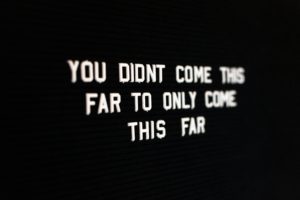Strategy and Vision are buzzwords. They’ve basically lost their meaning, which is unfortunate because they mean a lot. And that meaning can help you find business success. This post will examine the difference between strategy and vision, and how powerful they can be when they are brought together to help you find success.
Strategy vs Vision
Vision, simply put is defined as the things that you are actively working to accomplish. If you aren’t working toward your vision, then it’s just an idea. Steve Jobs’s vision was to create a computer small enough that it could fit in the palm of your hand. Nikola Tesla’s vision was to bring electricity to the masses. And they actively worked to make those real. Strategy is essentially how you go about accomplishing your goals. Jobs’s strategy was to cut the fluff and re-focus on Apple’s core competencies. Tesla’s strategy was to show people how safe AC electricity really was by putting on demonstrations across the nation. No matter what, there are four keys that you should consider when developing a strategy.
Strategic Development
Gen. Eisenhower once said, “plans are meaningless, planning is priceless.” He wasn’t meaning that we should improvise everything. Quite the contrary. Eisenhower was saying that the act of planning was invaluable. Planning requires we examine situations from all angles, and engage in destructive deduction and creative induction. As you create your strategy, be aware of these three keys.
1: Try to Follow the Optimal Path
As you work to make your vision real, the optimal path is the one that uses the fewest resources of time, money, and emotive energy. No one has walked it, but that doesn’t mean that we shouldn’t try. The best strategies are the ones that use the fewest amount of resources while producing the greatest level of return.

2: What is the Customer’s Job?
You aren’t selling what you think you are. Harvard Business Professor Theodore Leavitt highlighted this when he taught “people don’t want to buy a quarter-inch drill. They want a quarter-inch hole.” His colleague and my personal dashboard saint, Clayton Christensen said “people don’t buy your product or service. They hire it to help them make progress in their lives.” Your strategy has to be centered on helping your customer make progress.
3: Watch Your 6:00
In old war movies, the hero may have someone tell them to “watch [their] 6:00!” Meaning, pay attention to your surroundings. If you don’t, you might end up dead. Business is the same way. If you aren’t paying attention to your competitive landscape, you may end up like myspace, TiVo, BlockBuster, Sears, or a million other examples of businesses whose strategy didn’t account for new competition. Competitors may enter the market who do a better job at helping customers make progress than you do. It’s important to be in lock-step with the customer and their job, as well as the changes in the landscape and technology so you can continue to stay on top.

4: Vision, People, Processes
Vision, people, and processes is a framework by which the most durable businesses form. First, the founder has an idea that becomes solidified into a vision upon which they act. Then they share that vision with others and form a team to make that vision grow: including customers and employees. The team then puts the processes in place that bring the vision to life.
In a strategic sense, what this means is that you don’t develop your strategy in a vacuum, but rather need to have a team (even when you don’t have employees), time to brainstorm, and the tools to do the job right. Strategizing can take hours, so don’t be afraid to schedule regular weekly meetings with your trusted team until you’ve figured it out. You’ll also want to have a war-room, a quiet place with white/chalkboards where you can go and diagram the strategy without being disturbed, and the ability to access important data that you can analyze together to develop a strategy.
Measuring Strategic Effectiveness
How do you measure your strategy’s success? Let’s look at three:
1: Key Progress Indicators
There are a lot of Key Progress Indicators that you can use. It depends on your model and your strategy. The KPI for a medical practice may not necessarily include revenue because of the time lag associated with insurance claims. Their KPIs may be patients seen, projected collectibles by each provider, patient wait time, and other operations-related indicators. A retail business’s KPI’s would look different, and might include average inventory turnover time, daily sales revenue, customer browsing time, and others.
2: The Optimal Path
In life, we have three major resource constrictions: time, money, and emotive energy. These resources are extremely limited and dictate our ability to find success in business. So, a simple way to gauge the effectiveness of a strategy is to ask ourselves, is this bringing in more money, giving me more time, or increasing my emotive energy? If the answer is yes to one, then the strategy may be effective. Two “yes’s” means the strategy is probably effective. If you can answer yes to all three, then the strategy is certainly effective.

3: Are you gaining on your vision?
Finally, to measure your strategy’s effectiveness, ask: “am I getting close to my vision?” The whole purpose of the strategy is to get you to your vision. If you’re not making progress, then the strategy isn’t doing its job. Fire it and hire a new one.
Conclusions
The purpose of your strategy is to get you to your vision. If you can be aware of your limited resources and the job your customer is hiring you to do, as well as the strategic landscape you’ll have a leg-up on the competition. Develop your strategy with input from a team of trusted advisors. You’re even more likely to find success. Then, measure your strategy’s effectiveness using KPIs, reviewing your resources for growth, and focusing on whether or not you’re getting closer to your vision. Adjust when necessary!


